This is an elaborated version of my talk at Google Developer Group Chennai’s DevFest2025, where I shared my journey from rock bottom to becoming an Android Developer at Zoho and how the “Solutionist Mindset” can help us thrive in the age of AI.
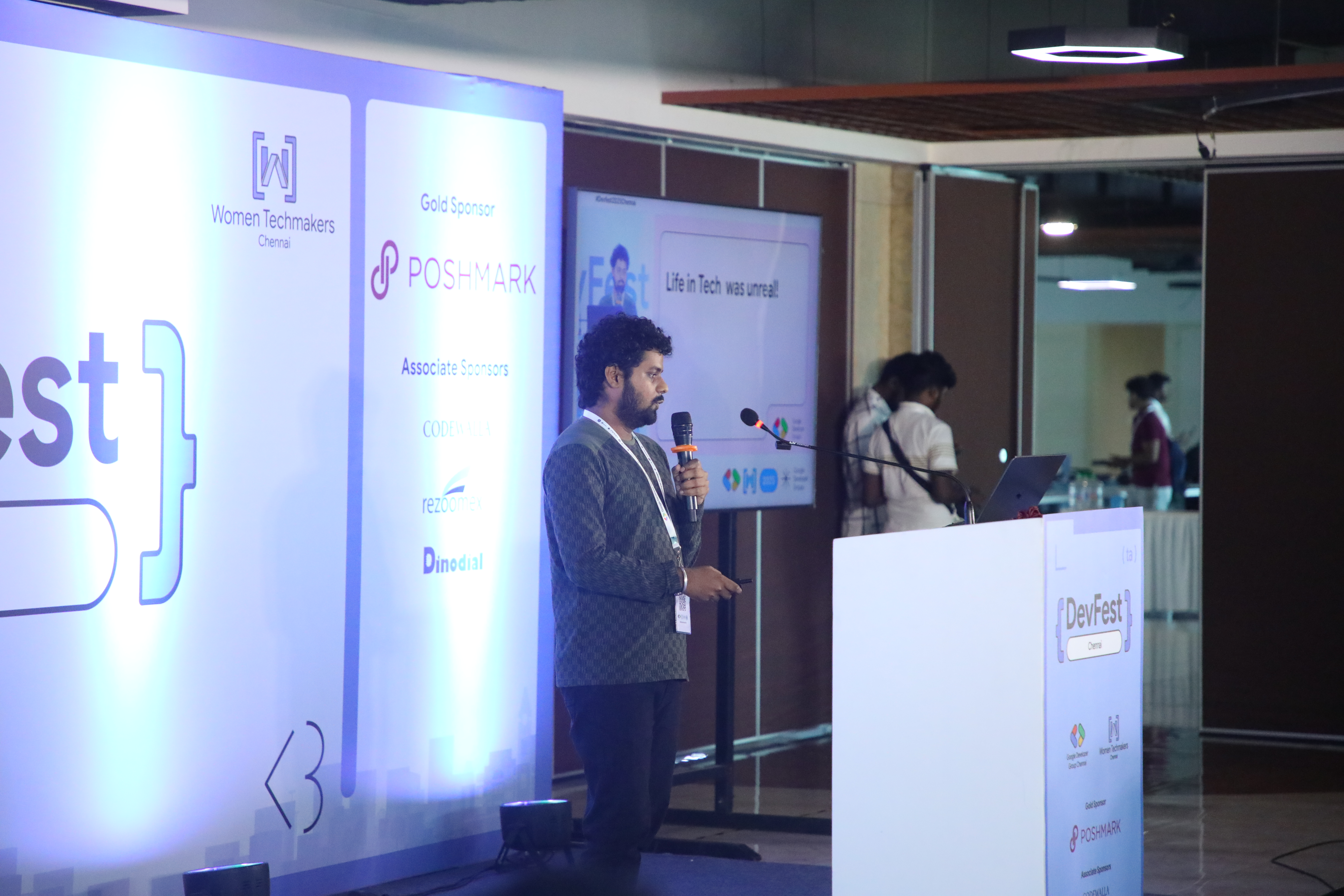
Standing on that stage at DevFest2025 in Chennai, looking out to you all, I asked a simple question: “How many of you are worried about AI taking over your job?”
The show of hands was overwhelming (some shared why they are confident too, I wish I was them). The anxiety in the room was palpable.
I get it. I’ve been there. In fact, I’m still navigating these waters myself. As an Android Developer at Zoho, I’ve watched AI tools evolve from curiosities to formidable coding partners. They’re impressive—spitting out code 10 to 100 times faster than we can. It’s almost unsettling, watching something produce in minutes what would take us hours or days.
The predictions are scary. The layoff numbers are even scarier. Tech Twitter is full of doom-scrolling material about how AI will replace developers, how junior positions are vanishing, how the barrier to entry is impossibly high now.
So I did what any rational person would do—I took a step back and contemplated this deeper.
What’s the worst thing that can happen to me?
And then I realized something profound: I’ve been through worse.
Rock Bottom: Varanasi, December 2017
Let me share something deeply personal with you. Something I don’t talk about often, but something that fundamentally changed how I approach adversity.
In December 2017, my life fell apart.
Not in the dramatic, movie-like way—but in the quiet, suffocating way that creeps up on you. Emotionally stuck, I watched as friends I believed would be with me forever just… disappeared. The community I had built my identity around crumbled. My entire belief system, everything I thought I knew about life and relationships, shattered.
Losing all hope, I set out on what I genuinely thought would be my final journey: to Varanasi.
The Ghats of Varanasi
I spent weeks alone at the ghats with almost nothing. It was the coldest winter I’ve ever experienced, and I wasn’t prepared—not physically, not mentally, not emotionally.
Surviving on just one meal a day at a nearby temple, I would spend my days sitting by the river, gazing into the Ganges in silence. The helplessness, the solitude—it was unlike anything I had ever known before. Even now, years later, I struggle to put that experience into words.
Imagine this: You’re standing at the crossroads of chaos. Motion swirls all around you—boats on the river, pilgrims performing rituals, the constant murmur of life and death existing side by side. Yet despite all this movement, you’re paralyzed. You can’t decide where to step next. Your mind feels numb. The whole experience is so overwhelming that language itself becomes inadequate.
But here’s what that experience taught me: Clarity doesn’t come from escaping pain. It comes from sitting with it, accepting it, and taking it in as a lesson from the universe.
When you’ve sat at the ghats of Varanasi, contemplating the impermanence of everything while watching funeral pyres burn and pilgrims bathe, the fear of losing a job to AI becomes… manageable. Not trivial—but definitely manageable.
Fast Forward: Finding Auroville
After a few more reality checks and life lessons (because apparently, Varanasi wasn’t enough), I came across Auroville and its unique philosophy around money and community living.
For those unfamiliar, Auroville is an experimental township in Tamil Nadu, founded on the principles of human unity, sustainable living, and spiritual evolution. Their approach to money and work fascinated me—the idea that work should be about contribution, not just compensation.
I felt drawn to it. It seemed like a place that resonated with what I was searching for—a new way of living, a new framework for understanding my place in the world.
Reality Meets Philosophy
When I arrived, I realized that while the philosophy was inspiring, it was still very much a work in progress—an idea in the process of becoming real. The gap between the ideal and the reality was significant. But you know what? That’s okay. That’s how all great experiments work.
Yet, amidst that gap, I found something invaluable: a warm, accepting community and my very first job at a busy guest house.
I started as a waiter. Then I worked my way up—biller, receptionist, whatever was needed. Each role taught me something new about human interaction, problem-solving, and the simple dignity of work.
It was genuinely educative in ways a classroom never could be. I learned about hospitality, about managing stress during rush hours, about the intricate dance of keeping customers happy while maintaining operational efficiency.
But there was one problem that bugged me daily, especially at the billing counter.
My First Solution: The Python Calculator
Restaurants in Auroville had unique discount structures that reflected their community-oriented values:
- 10% off for volunteers
- 20% off for Auroville residents
- Plus 5% GST for regular guests
Simple enough, right? Except during rush hours, when we had to calculate all this manually using a calculator.
Picture this: It’s lunch rush. The kitchen is yelling that orders are backing up. Customers are waiting, getting increasingly impatient. You’re trying to calculate percentages on a basic calculator while keeping track of multiple bills, and someone changes their mind about their order halfway through.
It was absolute chaos.
So, I did something I had never done before—I wrote a simple Python Tkinter app to simplify this process.
The Joy of Building Your First Solution
Now, to any experienced developer reading this, a Python Tkinter calculator probably sounds laughably simple. And it is. But back then, for someone with minimal programming experience, it was transformative.
It took me a couple of days and several iterations. The first version was buggy. The UI was ugly. But it worked. And during the next busy lunch rush, it saved my sanity.
This was my first real solution. Not a tutorial project. Not a homework assignment. A real problem, solved with real code, that helped real people.
Looking back now, it’s not sparkly or impressive. I wouldn’t put it in my portfolio. But it was a huge milestone in my journey. It empowered me to believe that I could build tools to solve problems.
The AI Comparison
Here’s the kicker: If I faced the same problem today, with access to Claude, GPT-4, or Copilot, it would take me 5 minutes or less to build the same thing. Probably better, with proper error handling and a cleaner UI.
That’s both amazing and terrifying. Amazing because of the productivity boost. Terrifying because if I were starting my journey today, would I have learned the same lessons? Would I have struggled enough to truly understand the fundamentals?
This is the paradox we’re living in.
The Bootcamp: Zoho Schools of Graduate Studies
After a while working at the restaurant, things were getting repetitive. I could do the job in my sleep. The initial learning curve had flattened out completely.
Then, I was given an opportunity to participate in the Zoho Schools of Graduate Studies (ZSGS)—a pilot 3-month fast-track program into software development.
There were interviews. There were coding tests. There were problem-solving assessments.
But you know what stood out during my interview? That custom calculator project I built to solve the billing problem.
It wasn’t the fanciest project. It wasn’t built with the latest framework or deploying cutting-edge architecture. But it demonstrated something crucial: I could identify a problem and build a solution.
The Underdog Journey
With a few more rounds of interviews and small projects, I was accepted into the program. But here’s the thing—acceptance didn’t guarantee employment at Zoho. It just meant you’d get direct interviews if there were openings afterward.
And I wasn’t under any illusion about my chances.
I was the only individual with just an SSLC (10th grade) certificate among some incredibly bright minds with degrees in Computer Science, Electronics, Mathematics, and various other technical streams. On paper, I was the least qualified person in that room.
But I knew one thing: I could give my absolute best and absorb everything like a sponge.
I was like a thirsty man stumbling upon an oasis—desperate to quench my thirst by learning everything I possibly could.
The Learning Environment
The program was intense. We learned data structures, algorithms, software design principles, databases, and practical software development. But more than the technical content, it was the mindset shift that mattered.
My mentors didn’t just teach me how to code—they taught me how to think. How to break down complex problems. How to ask the right questions. How to learn independently.
The other students, despite their impressive credentials, were incredibly supportive. We learned from each other, challenged each other, and grew together.
Thanks to my mentors and the collaborative environment, I managed to not just survive, but thrive.
The Interview
And the first team that interviewed me at the end of the program? They took me in.
Not because of my credentials (I had none). Not because of my degree (I had none). But because I demonstrated the ability to learn, adapt, and build solutions.
That’s how I became part of this wonderful tech world. Not through traditional credentials, but through small projects, relentless learning, and incredible mentors who saw potential where others might have seen only limitations.
A Glimpse of Tech Life
After joining a team at Zoho, I slowly started getting accustomed to this new life—realizing how incredibly fortunate I was to be on an autodidactic journey that felt like a dream.
Learning, growing, and getting paid for it? It seemed almost too good to be true.
The Difference from Previous Jobs
Unlike any job I’d had before—waiter, receptionist, biller—this one was fundamentally different. Everything I learned for work actually empowered me personally. It felt like one of those rare systems where the more you give, the more you grow.
It was like tending a bonsai tree—carefully shaped by external constraints and guidance, yet every bit of effort you put in feeds your own roots, strengthens your own foundation.
I was getting paid to:
- Learn new technologies
- Experiment with different approaches
- Build features that many would use
- Solve genuinely interesting problems
It felt unreal. It felt like the job I had dreamed about during those cold nights in Varanasi.
The Honeymoon Phase
For a couple of years, it was blissful. The learning curve was steep but manageable. Android development was evolving rapidly—Kotlin was gaining traction, Jetpack Compose was being introduced, and the ecosystem was thriving.
I threw myself into it. I learned Kotlin inside and out. I became proficient in Android architecture patterns. I contributed to significant features in our products.
For a while, I felt secure. I had carved out expertise. I had value.
And then… the AI wave hit.
Then AI Happened
ChatGPT launched in November 2022. At first, it was a curiosity. We played with it, asked it silly questions, marveled at its responses.
Then GitHub Copilot became mainstream. Then GPT-4 arrived. Then Claude. Then specialized coding models like Codex and Replit Ghostwriter.
Watching AI get better at coding, debugging, and doing things that used to be uniquely ours—suddenly, that old fear came back.
Not the fear of losing everything (I’d survived that in Varanasi). But the fear of becoming irrelevant was just as scary in a different way.
The Existential Questions
What happens when the skills we’ve painstakingly built over years suddenly don’t matter anymore?
What happens when a fresh graduate with AI assistance can be as productive as a senior developer?
What happens when companies realize they can maintain codebases with fewer people because AI handles the routine work?
These weren’t hypothetical questions anymore. They were becoming reality. The layoff announcements from major tech companies included explicit mentions of “productivity improvements through AI” as justification.
The Essay That Changed My Perspective
Around that time, in one of our team discussions about the future of software development, my manager shared an essay from 1932 by Bertrand Russell called “In Praise of Idleness.”
Has anyone here read it? If not, I highly recommend it.
Russell wrote this during the Great Depression, when millions were unemployed and the world was in economic turmoil. Yet his argument wasn’t about working harder to save the economy—it was about working smarter and questioning the entire premise of constant labor.
Russell’s Radical Idea
Russell argued that modern civilization had created a moral trap where we measure human worth by hours worked, not by problems solved or lives improved.
He believed that if machines could handle labor, we shouldn’t artificially create more meaningless work just to keep people busy. Instead, we should use that freedom for:
- Creativity
- Learning
- Art
- Philosophy
- Solving problems that actually matter
Think about that. Written in 1932, before:
- Computers
- The Internet
- Mobile phones
- Artificial Intelligence
Yet it feels like it was written specifically for us, right now, in 2025.
The Question Reframed
Russell’s essay helped me reframe the question entirely.
It’s not “Will AI replace us?”
It’s “What will we do with the freedom AI creates?”
Tasks that used to take weeks or months of research, development, and iteration now take hours or days thanks to AI assistance.
Yes, there will be side effects:
- Layoffs
- Reduced entry-level positions
- Increased pressure on individual productivity
- Market corrections
But these aren’t permanent states—they’re transition periods. And the question for each of us is: How do we position ourselves to thrive in this transition?
Breaking Out of the Box
For years, I had confined myself to what I call a “boxed developer” mindset.
Everything revolved around:
- Kotlin
- Android
- Jetpack Compose
I was good at it. I was comfortable. I could solve most Android problems thrown my way.
But I realized that comfort was becoming a cage.
The Title Trap
We do this to ourselves, don’t we? We accept titles and roles that become our entire identity:
- “I’m an Android Developer”
- “I’m a Frontend Engineer”
- “I’m a Backend Specialist”
These titles are useful for resumes and LinkedIn profiles. They help us find jobs. They give us a sense of expertise.
But they also limit our view. They keep us from looking beyond what our immediate work needs us to see.
Developer vs. Solutionist
Here’s the crucial distinction I’ve discovered:
A developer writes code to win bread. They learn what they need to stay employed. They specialize to remain valuable. It’s transactional.
A solutionist goes much deeper. They enjoy and learn every bit they can, like a magnet drawn to new knowledge. They’re driven by curiosity and the joy of solving problems, not just by paychecks.
The developer asks: “What do I need to know for my job?”
The solutionist asks: “What do I need to know to solve this problem effectively?”
See the difference?
Staying Relevant: Build Continuously
This distinction matters immensely because once the AI tsunami completes its first wave, the next one is already forming.
Quantum computing advancements. More sophisticated AI models. New paradigms we haven’t even conceived of yet.
Staying relevant through all of these requires constant adaptation and learning.
My proposition for navigating this? BUILD CONTINUOUSLY.
Why Build More?
Because what better way to learn than building projects?
Not theoretical knowledge. Not tutorial hell. Not certifications that gather dust.
Actual projects that solve real problems faced by real humans (even if that human is just you).
The Compounding Effect of Small Projects
Just like that simple billing calculator I mentioned earlier—you never know where a small project might lead.
After experiencing the joy of building that first solution, I built many more:
- A personal expense tracker (because existing ones didn’t fit my mental model)
- A community link-sharing platform (to solve coordination problems in my friend group)
- A personal task management system (because I needed something simpler than Notion but more structured than notes)
- Various automation scripts for repetitive tasks
All of these are available on my website. Are they perfect? Absolutely not. Do they have bugs? Definitely. Are they going to change the world? Probably not.
But they’ve changed my world.
What Building Teaches You
Building small things consistently transforms you:
You see problems differently - Instead of complaining about inefficiencies, you see opportunities to build solutions.
You stop feeling stuck - There’s always something you can build, always some small improvement you can make.
You develop taste - You understand what makes software feel good to use because you’re both the builder and the user.
You become resilient - When things break (and they will), you learn to fix them. When approaches don’t work, you pivot.
You evolve unexpectedly - You slowly become someone you didn’t know you could become. Skills compound. Confidence grows.
So, What Is a Solutionist?
After all these stories and reflections, let me give you a concrete definition:
A Solutionist isn’t defined by tools, but by problems solved.
They are:
- Language-agnostic
- Framework-flexible
- System-aware
- Problem-focused
The Four Traits of a Solutionist
Through my journey and observation of people I admire, I’ve identified four core traits:
1. Empathy — Understanding People, Not Just Specs
The best solutions come from understanding the human problem, not just the technical specification.
This means:
- Putting yourself in the user’s shoes
- Understanding their frustrations, not just their feature requests
- Recognizing that “make it faster” often means “I feel frustrated waiting”
- Seeing the emotional journey, not just the user journey
When I built that billing calculator, I wasn’t solving a math problem. I was solving the stress and anxiety of my colleagues during rush hours.
2. Systems Thinking — Seeing Ripple Effects
Nothing exists in isolation. One change ripples through everything.
Systems thinking means:
- Understanding dependencies and consequences
- Recognizing that “fixing” one thing might break another
- Seeing the whole forest, not just the tree you’re debugging
- Appreciating long-term implications of short-term decisions
In Android development, this might mean understanding how a seemingly innocent change in a shared ViewModel might affect multiple screens, or how a database migration could impact app startup time.
3. Lifelong Learning — Venturing Into the Unknown Without Fear
The moment you stop learning, you start becoming obsolete.
Lifelong learning means:
- Being comfortable with being a beginner again and again
- Exploring technologies outside your comfort zone
- Reading papers, essays, and documentation for things you don’t “need” yet
- Understanding that every new skill multiplies with every previous skill you’ve learned
From SSLC certificate to Android Developer to exploring AI/ML, backend systems, DevOps—each layer adds new dimensions to how you solve problems.
4. Communication — Bridging Technical and Non-Technical Minds
The best solution is useless if no one understands it.
Communication means:
- Explaining complex technical concepts to non-technical stakeholders
- Writing documentation that actually helps
- Listening actively to understand requirements beneath the surface
- Collaborating effectively across disciplines—design, product, business
I’ve seen brilliant solutions fail because they were explained poorly. And I’ve seen simple solutions succeed because they were communicated effectively.
AI as Freedom: Russell’s Prophecy Coming True
When AI arrived, many feared job loss. And yes, that’s happening in some sectors.
But what if Russell was right all along?
What AI Actually Removes
AI removes:
- Repetitive, mechanical work
- Boilerplate that makes our days feel routine
- The cognitive load of remembering syntax
- The tedium of debugging simple logic errors
It gives time back for:
- Creativity
- Empathy
- Real problem-solving
- Strategic thinking
- Learning deeply instead of superficially
Vibe Coding: Thanks to Andrej Karpathy
This is where ‘vibe coding’ comes in—a term popularized by Andrej Karpathy.
Let AI help you move faster. Let it handle the repetition, the boilerplate, the syntax you can never quite remember.
But—and this is crucial—understand what it’s changing.
Know the patterns. Understand the tweaks. Grasp the reasoning behind every line it suggests.
The Danger of Blind Coding
If you code blindly, just accepting whatever AI suggests without understanding:
- You lose the joy of building
- You become oblivious to your own vision
- You can’t debug effectively when things inevitably break
- You stop learning and start copy-pasting
AI should be your copilot, not your pilot. You’re still flying the plane.
How to Actually Start: Practical Steps
Enough philosophy. Let’s talk practically.
Want to build something? Here’s what I’ve learned through building multiple projects with AI assistance:
Step 1: Start with the Problem
Write it down. Not the solution—the problem.
Ask yourself:
- What are you trying to solve?
- Who are you solving it for?
- Why does this problem matter?
- What does success look like?
Be specific. “I want to build a todo app” is not a problem. “I keep forgetting to follow up on important emails, and existing todo apps don’t integrate well with my email workflow” is a problem.
Step 2: Document Your Vision First
Before you write a single line of code, create a clear vision of what you’re building and why.
Your first commit should be your vision, not your code.
This document becomes your North Star. When AI suggests clever solutions that drift from your vision, you can catch it. When scope creep tempts you, you can resist it.
Step 3: Use AI to Move Fast, But Understand Everything
This is the balance:
- Let AI generate boilerplate → But understand the structure it creates
- Let AI suggest solutions → But understand why those solutions work
- Let AI write tests → But understand what they’re testing and why
Know the patterns. Understand the tweaks. Grasp the reasoning behind every line.
If you find yourself accepting suggestions without understanding them, stop. Research. Learn. Only then proceed.
Step 4: Iterate Deliberately
Add features one at a time.
Track changes with Git. See what’s happening at each step.
This isn’t just about version control—it’s about understanding the evolution of your project. Each commit is a story. Each feature is a chapter.
Deliberate iteration means:
- Build one thing
- Test it thoroughly
- Document what you learned
- Commit it
- Move to the next thing
Step 5: The Tools Don’t Matter. The Mindset Does.
I cannot stress this enough.
The language doesn’t matter. The framework doesn’t matter. The cloud provider doesn’t matter.
What matters is:
- Do you understand the problem?
- Does your solution solve it effectively?
- Can you explain why you made the choices you made?
- Did you learn something building it?
That’s all that matters.
The Real Power: Wearing All the Hats
When you build your own projects, you’re not just a developer.
You’re everything:
- Visionary — Defining what should exist
- Product Manager — Prioritizing features
- Designer — Crafting the experience
- Developer — Building the solution
- QA — Testing and breaking things
- DevOps — Deploying and maintaining
- Support — Handling bugs and feedback
The Freedom This Gives You
Maybe you’ll build something the world uses. Maybe not.
Either way, it’s yours. It’s your journey.
In a typical software job, you might not get to wear all these hats due to company policies and defined roles. You’re the “backend developer” or the “mobile engineer” or the “frontend specialist.”
But here, on your own project, you are the boss. The founder. The everything.
This level of ownership is both daunting and incredibly empowering.
The Career Impact
I’m certain that this experience—building complete projects from vision to deployment—will help you solve day-to-day professional problems much faster.
Because you’ve seen the whole picture. You understand how the pieces fit together. You’ve debugged across the stack. You’ve made tradeoffs and lived with the consequences.
That holistic understanding is invaluable and increasingly rare in our specialized world.
Start Today: Your Action Items
Don’t wait. Don’t prepare. Don’t plan endlessly.
Start small. Start now.
Pick One Frustrating Problem
Look at your daily life. What frustrates you repeatedly?
- Tracking expenses?
- Managing reading lists?
- Coordinating with friends?
- Remembering to water plants?
- Finding recipes based on ingredients you have?
Pick one. Just one.
Don’t Chase Perfection. Chase Progress.
Your first version will be ugly. It will have bugs. It will be embarrassing to show others.
Build it anyway.
Because version 0.1 is infinitely better than the perfect app that exists only in your imagination.
Use Every Project as a Playground
Want to learn a new framework? Use it for your next project.
Curious about a new database? Try it.
Interested in a new deployment strategy? Experiment.
Every project is an opportunity to play, to experiment, to learn.
Every Problem Solved Is Progress
Each problem solved is one step closer to being a Solutionist.
Not because you’re accumulating credentials or certificates, but because you’re training yourself to see opportunities where others see obstacles.
Closing: Reclaiming Purpose
When my manager first sent me “In Praise of Idleness,” I thought it was ironic. Here we are, working in tech, and he’s sending me an essay about working less?
Now I see the wisdom.
It’s not about doing less. It’s about doing better.
It’s about focusing on work that matters, that challenges us, that makes us grow.
What AI Can’t Replace
We’ve built technology powerful enough to automate tasks, but not powerful enough to replace people who bring meaning to them.
AI can:
- Write code
- Debug programs
- Architect systems
- Generate tests
- Refactor codebases
But it can’t:
- Understand why we build
- Feel empathy for users
- Ask deeper questions about impact
- Navigate the human complexities of real projects
- Find purpose in the work
That’s still our job. Always will be.
The World Needs Solutionists
The world doesn’t just need coders. We have enough people who can write syntactically correct code.
The world needs people who:
- See problems and craft thoughtful solutions
- Combine empathy with engineering
- Explore fearlessly and learn relentlessly
- Ask “why” as often as they ask “how”
- Reclaim purpose in a world obsessed with productivity
Don’t Confine Yourself to a Box
So don’t confine yourself to a box labeled “Android Developer” or “Frontend Engineer” or “Data Scientist.”
Explore. Venture into the unknown.
Build. Create things that matter to you.
Reflect. Learn from what works and what doesn’t.
Be a Solutionist.
Because the world doesn’t just need more developers.
It needs you.
Thank You
First and foremost, a huge thank you to Google Developer Group Chennai for organizing DevFest2025 and giving me this incredible platform to share my journey and thoughts with the community.
To all the volunteers who worked tirelessly behind the scenes—setting up the venue, managing logistics, helping attendees, and ensuring everything ran smoothly—you are the unsung heroes who make events like this possible. Your dedication and energy created the welcoming atmosphere that made DevFest2025 special.
A special thanks to all the sponsors who believed in this event and invested in our developer community. Your support makes it possible for us to gather, learn, share, and grow together.
To the GDG Chennai organizers and core team members—thank you for building and nurturing this vibrant tech community in Chennai. Your consistent efforts to bring developers together, facilitate learning, and create opportunities for knowledge sharing are truly invaluable.
To everyone who attended the talk and engaged with these ideas—your questions, your reflections, your nodding heads, and even your skeptical looks made this talk so much more meaningful. The conversations we had afterward were some of the most enriching parts of the entire experience.
And to you, reading this now—whether you attended DevFest2025 or are discovering this for the first time—I hope something here resonates. I hope it sparks something in you.
Now let’s build something.
Sone of the feedbacks from Participants
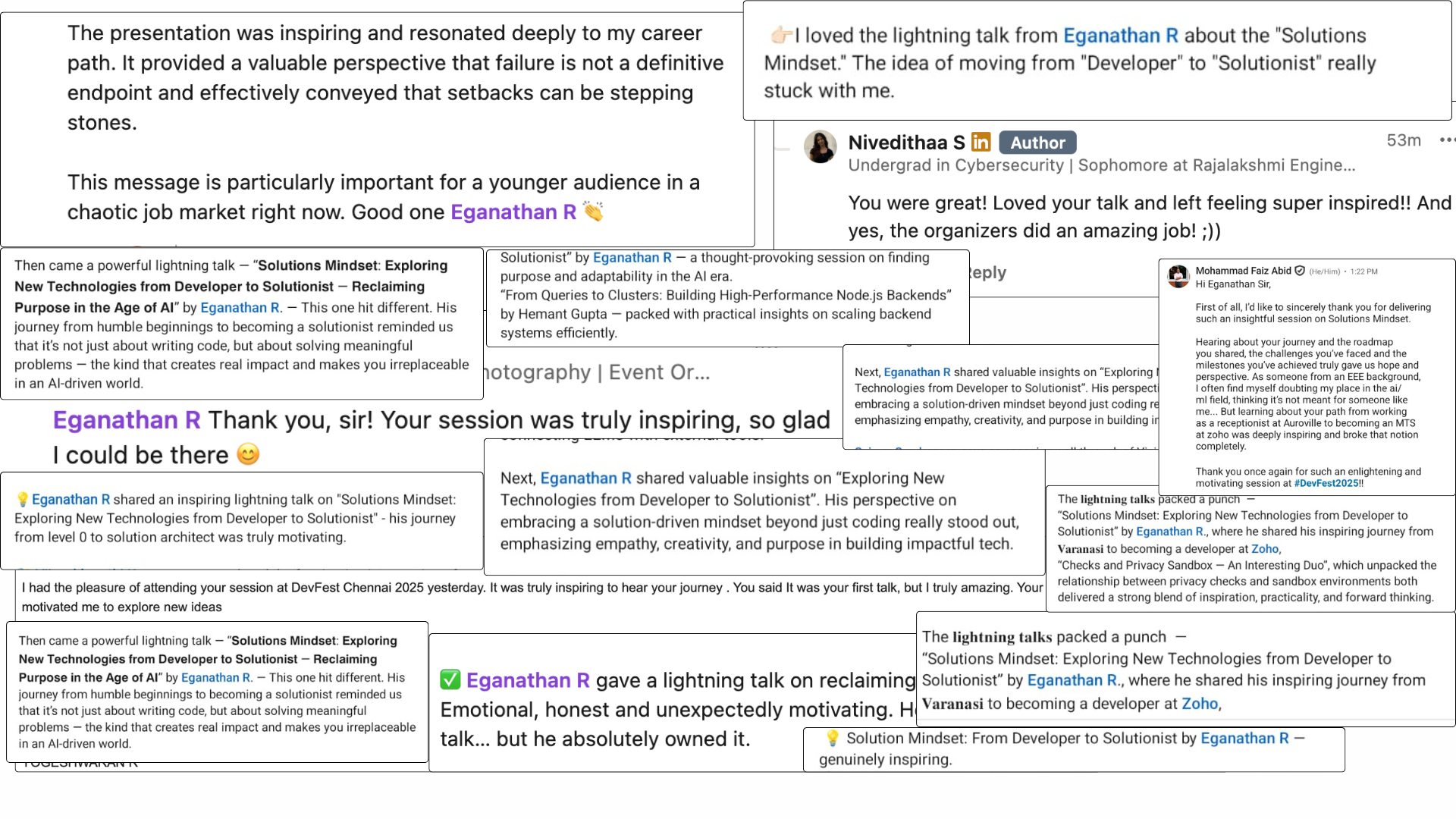 Heartwarming feedback from the DevFest2025 participants
Heartwarming feedback from the DevFest2025 participants
Event Highlights
Here are some moments from DevFest2025:
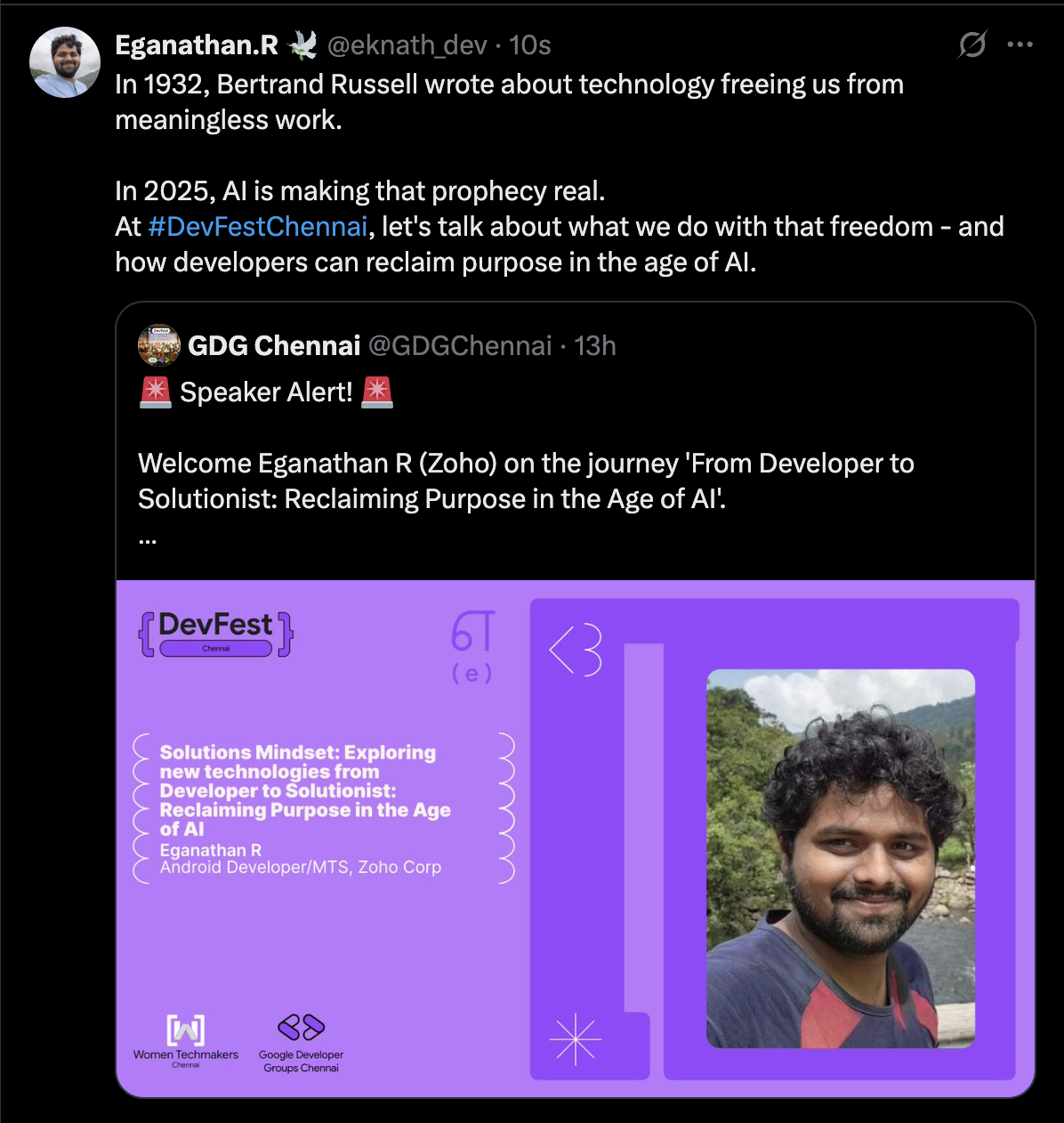 The announcement that started it all
The announcement that started it all
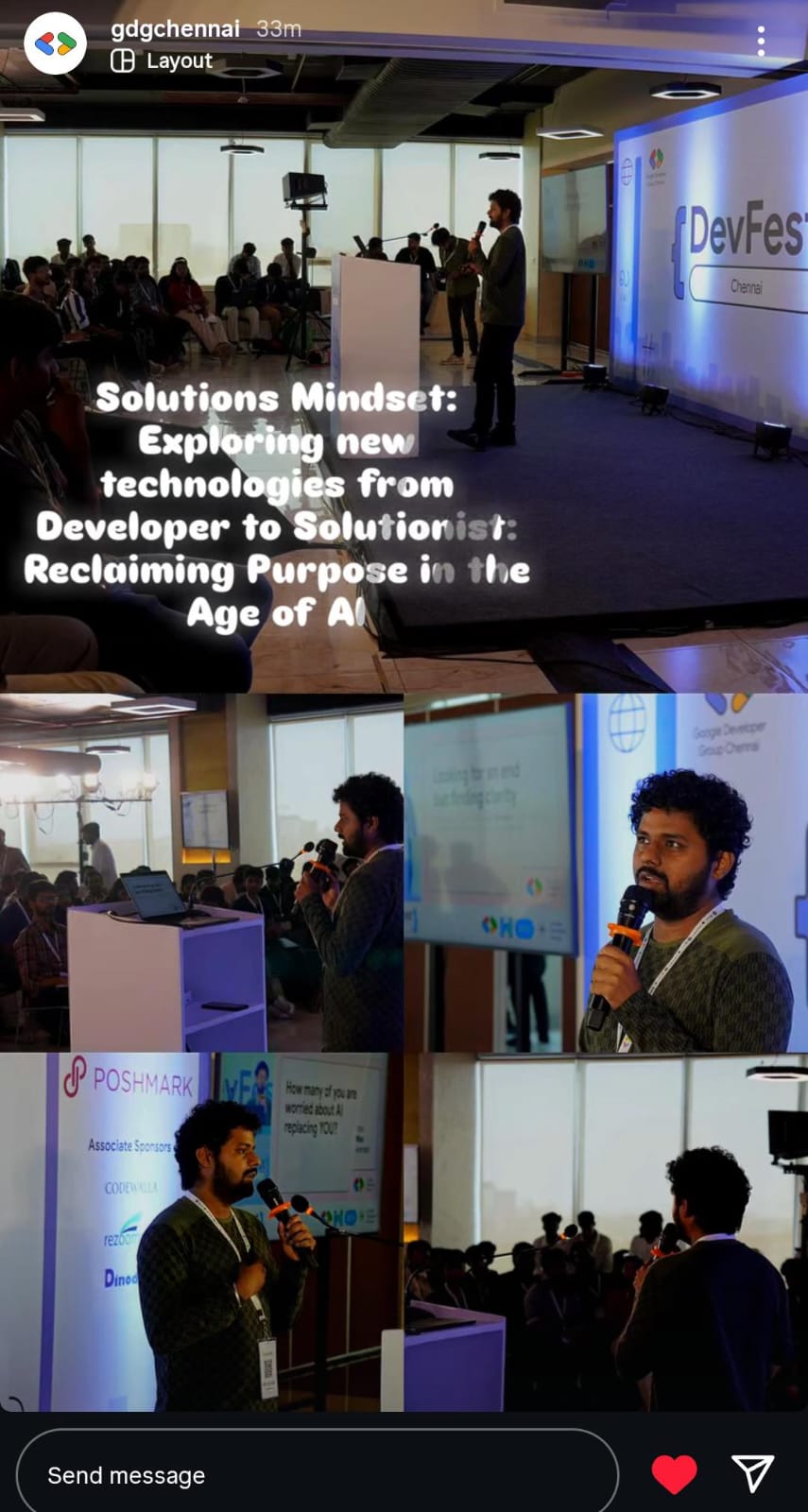 Sharing the Solutionist Mindset with the DevFest2025 community
Sharing the Solutionist Mindset with the DevFest2025 community


.JPG)

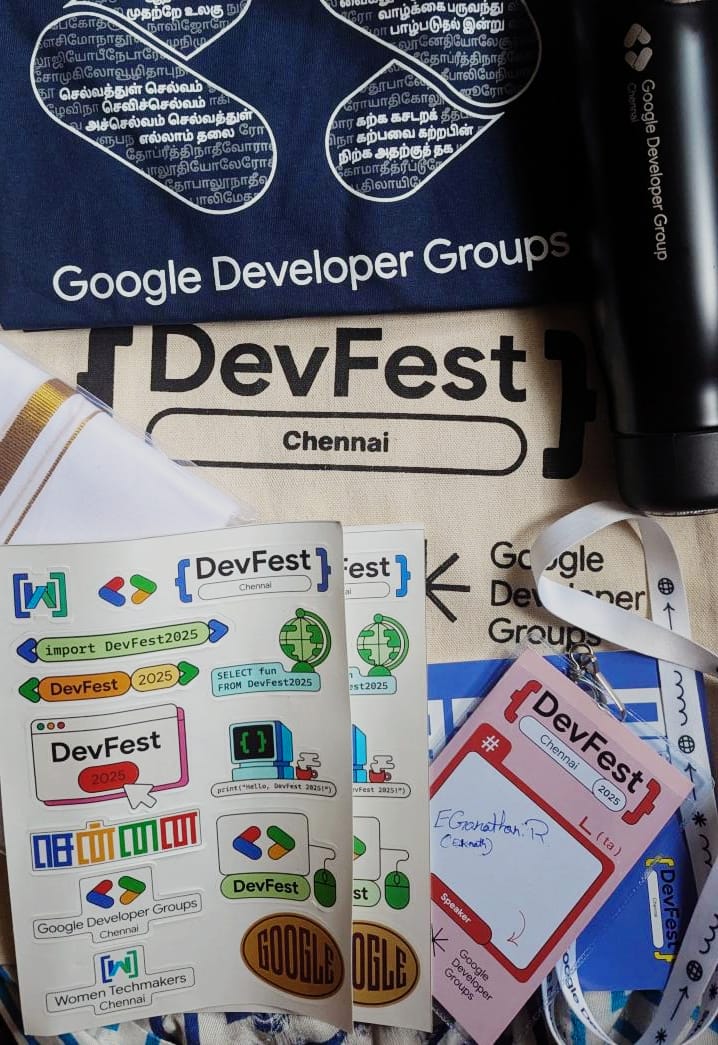 The speaker goodies bag - thanks GDG Chennai! For everyone who asked what’s inside: GDG swag, stickers, and some awesome tech goodies!
The speaker goodies bag - thanks GDG Chennai! For everyone who asked what’s inside: GDG swag, stickers, and some awesome tech goodies!
If you want to discuss any of these ideas further, or if you’re building something and want to share your journey, feel free to reach out. I’m always excited to connect with fellow solutionists.
All my projects are available on my website. They’re not perfect, but they’re mine, and they’re continuously evolving. Just like me. Just like you.